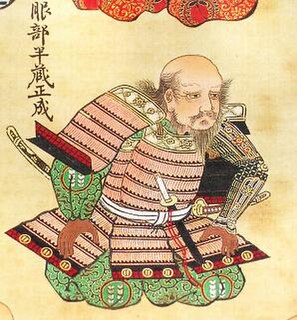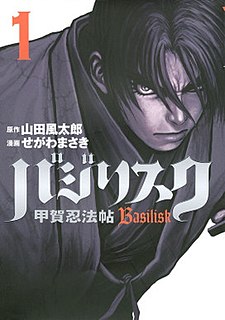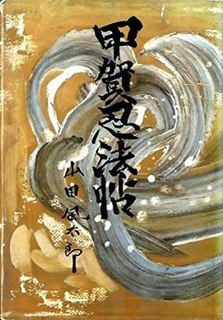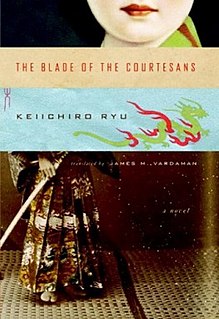
A ninja or shinobi was a covert agent or mercenary in feudal Japan. The functions of a ninja included reconnaissance, espionage, infiltration, deception, ambush, bodyguarding and their fighting skills in martial arts, including ninjutsu. Their covert methods of waging irregular warfare were deemed dishonorable and beneath the honor of the samurai. Though shinobi proper, as specially trained spies and mercenaries, appeared in the 15th century during the Sengoku period, antecedents may have existed as early as the 12th century.

Yagyū Munenori was a Japanese daimyo, swordsman, and martial arts writer, founder of the Edo branch of Yagyū Shinkage-ryū, which he learned from his father Yagyū "Sekishūsai" Muneyoshi. This was one of two official sword styles patronized by the Tokugawa shogunate. Munenori began his career in the Tokugawa administration as a hatamoto, a direct retainer of the Tokugawa house, and later had his income raised to 10,000 koku, making him a minor fudai daimyō, with landholdings around his ancestral village of Yagyū-zato. He also received the title of Tajima no Kami (但馬守).
Yagyū Jūbē Mitsuyoshi was one of the most famous and romanticized of the samurai in Japan's feudal era.

Hattori Hanzō or Second Hanzō, nicknamed Oni no Hanzō, was a famous Ninja of the Sengoku era, who served the Tokugawa clan as a ninja, credited with saving the life of Tokugawa Ieyasu and then helping him to become the ruler of united Japan. He is often a subject of varied portrayal in modern popular culture. Hanzō was known as an expert tactician and a master of sword fighting.

Futaro Yamada was the pen name of Seiya Yamada, a Japanese author. He was born in Yabu, Hyogo. In 1947, he wrote a mystery short story Daruma-tōge no Jiken and was awarded a prize by the magazine Houseki (宝石). He was discovered by Edogawa Rampo and became a novelist. He wrote many ninja and mystery stories. Many of his works have been adapted for film, TV, manga, and anime.
Kirigakure Saizō (霧隠才蔵) was a legendary ninja of the final phase of the Sengoku period of Japan. In the folklore he is one of the Sanada Ten Braves, and next to Sarutobi Sasuke, he is the most recognized of the Ten.

Yōtōden is a 3-episode Japanese original video animation produced by J.C.Staff, the studio's first production. In 1989, Yōtōden was re-edited into a feature film version titled Wrath of the Ninja for English-speaking regions, but is currently out of print. A manga adaptation was serialized in Newtype.
Ninja Scroll: The Series is a 2003 Japanese anime television series based on Yoshiaki Kawajiri's Ninja Scroll. The series is directed by Tatsuo Sato and animated by Madhouse.

Basilisk is a Japanese manga series written and illustrated by Masaki Segawa. Based on the 1958 novel The Kouga Ninja Scrolls by Futaro Yamada, it was serialized in Kodansha's Young Magazine Uppers from 2003 to 2004. The story takes place in the year 1614. Two ninja clans, Iga of Tsubagakure and the Kouga of Manjidani, battle each other to determine which grandson of Tokugawa Ieyasu will become the next shogun. The deadly competition between 10 elite ninja from each clan unleashes a centuries-old hatred that threatens to destroy all hope for peace between them.
Fūma Kotarō was the name adopted by the leader of the ninja Fūma clan during the Sengoku era of feudal Japan. He was retainer of Later Hōjō clan. According to some records, his name was originally Kazama Kotarō.

The Kouga Ninja Scrolls is a historical fantasy novel about ninja written in 1958–1959 by the Japanese author Futaro Yamada. It is the first installment in Yamada's Ninja Scrolls series, which he wrote until his death in 2001. The book was translated into English by Geoff Sant, and published by Del Rey in December 2006.

Tail of the Moon is a Japanese shōjo manga series written and illustrated by Rinko Ueda. The series began serialization in Margaret magazine in 2002 and ran until 2007. The individual chapters have been collected into fifteen tankōbon volumes by Shueisha; the first on March 25, 2003 and the last on August 24, 2007. The series has been licensed by Viz Media for an English-language North American release as part of their Shojo Beat imprint.
Iga-ryū is an umbrella term for ninjutsu traditions that come from the Iga region, according to Japanese legend. It became one of the two most well-known ninja traditions in Japan. The Iga-ryū traditions originated in the Iga Province in the area around the towns of Iga, Ueno, and Nabari. Iga-mono is a synonym for Iga ninja.

The Blade of the Courtesans is a historical fiction novel by Japanese author Keiichiro Ryu originally published in 1986. It was published in English by Vertical Inc in 2008. Ryu's debut novel, it was nominated for a Naoki Award and "instantly made him a doyen of historical fiction."
Sekigahara (関ヶ原) is a 2017 jidaigeki Japanese film directed by Masato Harada starring Junichi Okada as Ishida Mitsunari. The film recounts the Battle of Sekigahara, a six-hour battle in 1600 that brought an end to the Warring States era in Japanese history, as well as the political struggles that led up to it. It is an adaptation of the 1966 novel Sekigahara by Ryōtarō Shiba.
Unmeitōge (運命峠) is a Japanese jidaigeki or period drama that was broadcast in prime-time in 1974. It is based on Renzaburō Shibata's novel of the same title. The lead star is Masakazu Tamura.
Hatsume no Tsubone (初芽局) is a fictitious Japanese woman from the Sengoku period. She is famous as the main character of the historical novel Sekigahara by Ryōtarō Shiba. In the novel, she is Kunoichi sent by Tokugawa Ieyasu to spy on his political enemy Ishida Mitsunari before the Battle of Sekigahara.
The Order of Musashi Shinobi Samurai is a Japanese shinobisamurai clan which served Tokugawa Ieyasu and the Edo Shogunate from 1582 to 1868. They served the Tokugawa Shogunate as intelligence operatives called onmitsu, and metsuke (inspectors), and in the 19th century, as diplomats. When the political system changed due to the restoration of the monarchy in 1868, it became independent. The order consists of a number of families and people who have built close relations of trust with the Shibata Clan of the Musashi Province.









